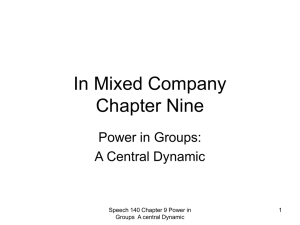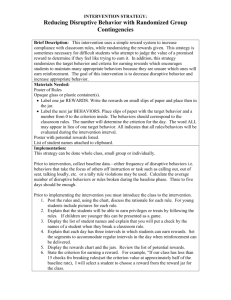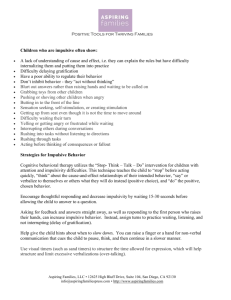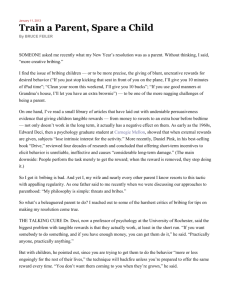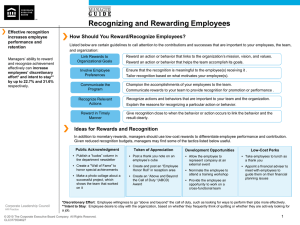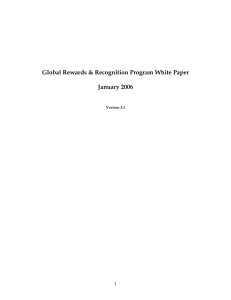PD2_Motivation_Satisfaction__Performance
advertisement
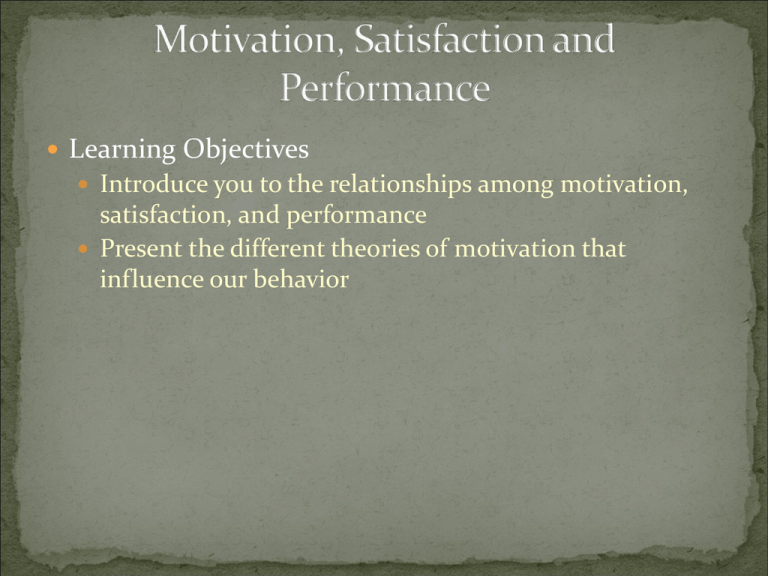
Learning Objectives Introduce you to the relationships among motivation, satisfaction, and performance Present the different theories of motivation that influence our behavior Gallup Poll estimates that if companies could get 3.7% more work out of each employee, the equivalent of 18 more minutes for each 8 hour shift, the gross domestic product in the US would swell by $355 billion. Motivation (Kanfer, 1990): anything that provides direction, intensity, and persistence to behavior Motivation is not directly observable; inferred from behaviors Performance: concerns those behaviors directed toward the organization’s mission or goals, or the products and services resulting from those behaviors Performance is a function of ability, motivation, and situational constraints/facilitating conditions Job satisfaction: affective feelings, attitudes about the job itself, pay, promotion or educational opportunities, supervision, coworkers, workload Those who are more satisfied with their jobs tend to engage in more organizational citizenship behaviors,OCBs (Organ & Ryan, 1995) OCB examples: help another employee with project, fill in for another employee, donate sick time for employee who has sick child Need Theory Assume we share common set of basic needs Needs: internal states of tension or arousal people are motivated to change Maslow Implications for Managers Research doesn't support all of Maslow's theory, but people do recognize higher & lower order needs. Job-based approaches using Maslow would seek to add esteem enhancers into an employee's job design, or allow for more social interaction in the job. Leadership-based approaches would appeal to the subordinate's need for esteem and fulfill it directly. The leader becomes the reinforcer and the promoter to satisfy esteem, actualization, or perhaps social needs of the subordinate. Individual Differences in Motivation Need for Achievement Degree to which a person strives to accomplish socially acceptable endeavors and activities Those with higher need tend to exert more effort to accomplish work assignments, goals, objectives (McClelland, 1975) Predicts success in school (Gough, 1987), military (Curphy & Otsen, 1993) and in managers (Nilsen, 1995) Implications for Managers Studies have shown that entrepreneurs are typically only high on the need for Achievement, while managers in bureaucratic organizations are high in need for Power and low in need for Affiliation. Like when we think about different personalities, the profiles of our subordinates should lead us to a contingency approach to leadership - one tailored somewhat to the individuals within our span of control. Job-based approaches emphasize proper selection and assignments so that the best match can be made between individual differences and the jobs. Leadership-based approaches match special and expanded duties to the work needed. Leaders can help the organization not to overlook the needs for affiliation, power, and achievement within the workforce. Intrinsic Motivation Behavior motivated for it own sake, for the personal satisfaction and increased feelings of competence or control one gets from doing it Implication: Provide rewards for intrinsically motivating tasks. However, must be careful the rewards are not perceived as controlling, but are perceived as informational Cognitive Theories Goal Setting: Locke & Latham (1990) posit that goals are one of the most powerful determinants of behavior Difficult and specific goals consistently related to higher effort and performance than “do your best” Goals must be attainable to be accepted Goal commitment: self-set equally effective as assigned, as long as leader is perceived to have legitimate authority, expressed confidence in followers, and provided clear standards of excellence Feedback: Followers exert greatest effort when goals are accompanied by feedback Expectancy Theory Assumptions Motivated performance is the result of conscious choice People will do what they believe will provide them the higher (or surest) rewards Effort-to-performance probability (Expectancy) Performance-to-outcome probability (Instrumentality) Valence, value of the reward Expectancy asks "If I make an effort am I likely to succeed at the performance?" Instrumentality asks "If I perform as required, will I receive the reward?" Valence asks "If I receive the reward, is it a valuable reward in my eyes?" IF the answers are all "yes" then I'm motivated to perform. If "no" then I'm not. Clearly the answers may be not so certain, and so researchers will compute percentages at each question and multiply to find an overall motivation number. Implication: Greater motivation will result when: Person can perform task adequately if they put forth the effort Person will be rewarded if they do it Person values the reward Implications for Managers Expectancy theory is perhaps the most useful tool in helping to make the workplace attain higher performance. It is perhaps most useful in Job-based approaches. Pay for performance plans seek to strengthen the instrumentality (the connection between the performance and the reward). Most pay systems don't, so what connection do they strengthen?. Perhaps seniority/service. Promotion and recognition programs are focused upon being instrumental. Training programs and successful prior job experiences strengthen expectancy. Leadership-based approaches emphasize the value of rewards, particularly when rewards aren't financial. Leaders also clarify the expectancies and instrumentalities for employees. Situational Approaches Job Characteristics Model Hackman and Oldham (1976, 1980): Workers will be more motivated if their tasks: Are performed beginning to end (task identity) Are meaningful (task significance) Provide ample feedback (feedback) Allow considerable latitude in deciding how to accomplish them (autonomy) Require use of a variety of skills (skill variety) Growth need strength Implications: Implement as many job characteristics as possible Operant Approach Thorndike’s Law of Effect Rewards Punishments Research: rewards tend to work better than punishments, especially when administered in a consistent manner (e.g., Stajkovic & Luthans, 2001; Podsakoff & Todor, 1985) Bill Parcels, Coach Knack for knowing how to motivate different players in different ways Mind games, telling a player there is no way he can outperform the superstars on the opposing team Has yelled at players to motivate them to achieve higher standards May act like a best friend or may challenge another to do better Operant Principles for Implementation Leadership practitioners need to clearly specify what behaviors are important determine if those behaviors are currently being punished, rewarded, or ignored find out what followers actually find rewarding and punishing be wary of creating perceptions of inequity when administering individually tailored rewards (be clear and consistent with rewards) not limit themselves to administering organizationally sanctioned rewards and punishments (social recognition and performance feedback resulted productivity improvements in followers of 24% and 20%, respectively; Stajkovic & Luthans) should administer rewards and punishments in a contingent manner whenever possible Implications for Managers People do not like to feel that they are being manipulated like a household pet, and so there is much resistance to having one's behavior modified. However, reinforcement is at the heart of most organizational systems. The biggest resistance is where the leader uses contrived or insincere reinforcers in a thinly disguised attempt to get the worker to do something. Job-based approaches build reinforcers into jobs and personnel systems. Leadership-based approaches build reinforcement tools & schedules into their personal approach with subordinates, but in a sincere, honest manner. Equity Theory Inputs (e.g., education, training, experience, effort, time, concentration) Outcomes (e.g., pay, promotion, respect) Ratio: personal I:O =? others I:O Overpayment or underpayment inequity, or equity Ways to Restore Equity: Cognitive Behavioral Implications for Managers Exchange and justice theories receive a lot of attention in research & at the workplace. Workers often complain about the lack of equity, or worse, adjust down their performance to compensate. Job-based approaches set up fair performance appraisal & reward systems. Complaint/grievance procedures also enhance perceptions of procedural justice. Leadership-based approaches enforce such systems, but leaders can also correct inequities, and/or refocus the employee to a more appropriate reference person. Leaders should also be aware that workers tend to overestimate the "deal" they think their bosses have.



